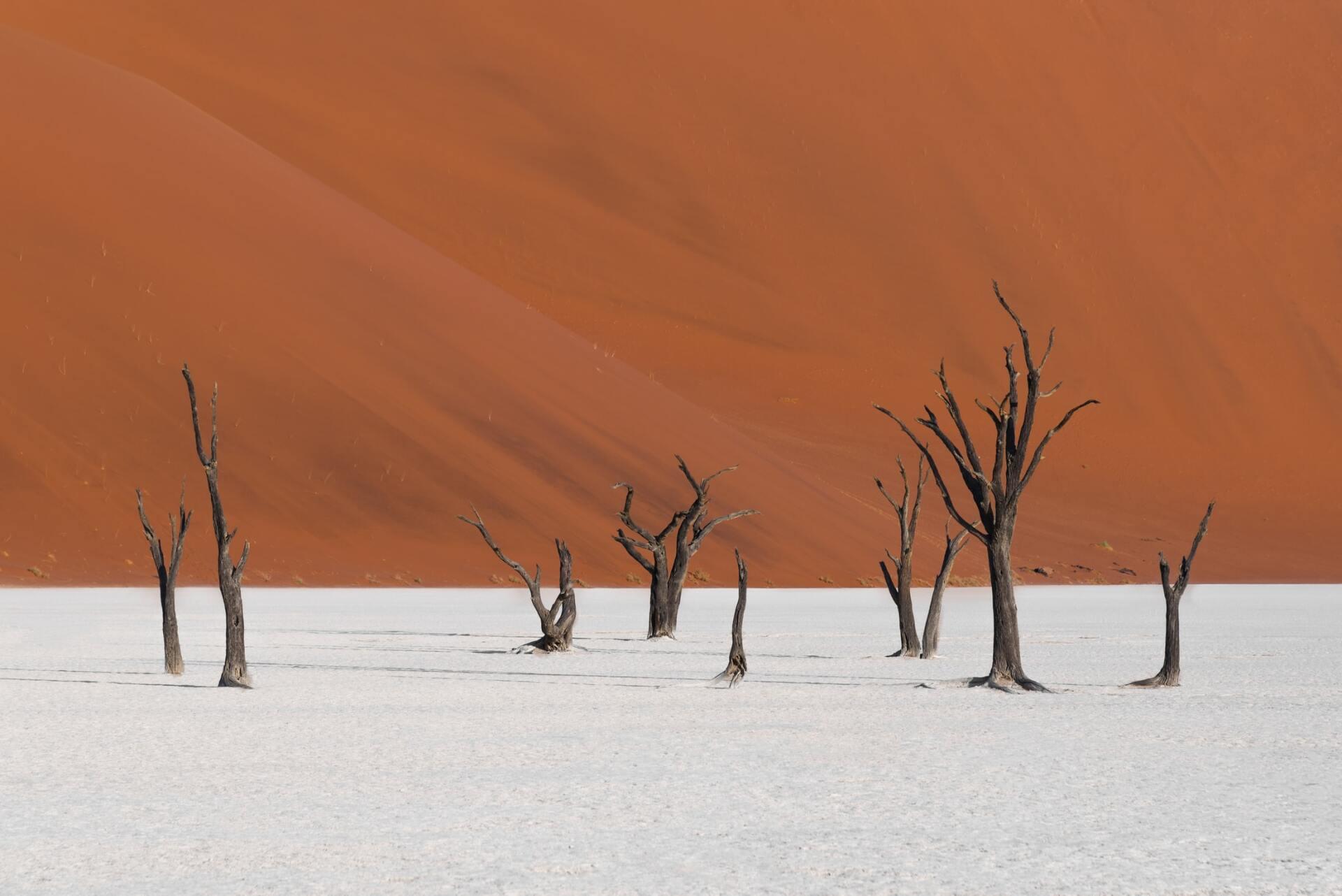Introduction
Nestled within the expansive Namib-Naukluft National Park in Namibia lies a surreal and hauntingly beautiful landscape known as Deadvlei. Surrounded by some of the highest sand dunes in the world, this ancient clay pan is a photographer’s paradise and a testament to the harsh yet stunning desert environment of the Namib Desert. Visiting Deadvlei is not just about witnessing its iconic camel thorn trees and contrasting white clay floor against the deep red dunes—it’s a journey into a timeless landscape frozen in the heart of one of Earth’s oldest deserts. Join us as we delve into everything you need to know to experience the magic of Deadvlei.
Location and Access
Deadvlei is situated approximately 60 kilometers from the entrance to the Sossusvlei area within the Namib-Naukluft National Park, which is accessible via the Sesriem Gate. The park is located in the southern part of Namibia and is best accessed by a four-wheel-drive vehicle due to the sandy terrain and remote location.
History and Formation
Deadvlei, which means “dead marsh” in Afrikaans, is believed to have formed over 900 years ago when the nearby Tsauchab River flooded, creating temporary shallow pools that allowed camel thorn trees (Acacia erioloba) to grow. Over time, the climate changed, and the dunes encroached on the area, blocking the river and causing the trees to die. The trees have since become blackened and scorched by the sun, preserved in the arid climate with little decomposition, creating a stark contrast against the white clay pan and vibrant red dunes.
Unique Landscape and Photography Tips
The landscape of Deadvlei is characterized by its white clay pan, which starkly contrasts with the towering orange sand dunes that surround it. This stark contrast, combined with the skeletal remains of the camel thorn trees, makes Deadvlei one of the most photogenic locations in the world. Here are some photography tips to make the most of your visit:
- Lighting: The best time to photograph Deadvlei is during the early morning or late afternoon when the sun casts long shadows and creates a warm glow on the dunes. This not only adds depth to your photos but also enhances the rich colors of the landscape.
- Composition: Experiment with different angles and perspectives to capture the vastness of the landscape and the scale of the dunes against the trees. Consider including a person in your shot to provide a sense of scale and perspective.
- Equipment: A wide-angle lens is ideal for capturing the expansive landscape of Deadvlei, while a telephoto lens can help you isolate individual trees or dune patterns. A tripod is essential for stability, especially during low-light conditions or long exposures.
- Timing: Plan your visit to Deadvlei early in the morning to avoid the harsh midday sun and crowds of tourists. The park opens at sunrise, allowing you to capture the soft morning light and serene atmosphere before temperatures rise.
Activities at Deadvlei
While Deadvlei itself is a relatively small area, the surrounding Sossusvlei region offers additional activities and attractions to enhance your visit:
- Big Daddy Dune: Climb the nearby Big Daddy Dune, one of the tallest sand dunes in the world, for spectacular views of Deadvlei from above. The climb is challenging but rewarding, offering panoramic vistas of the desert landscape that hiking on it should be prepared well.
- Sossusvlei: Visit the nearby Sossusvlei salt and clay pan, known for its iconic red dunes and seasonal water pools. The area is accessible via a short hike or 4×4 shuttle ride from the parking area.
- Hidden Vlei: Explore Hidden Vlei, another nearby clay pan featuring petrified camel thorn trees and a quieter, more secluded atmosphere compared to Deadvlei. Hidden Vlei offers unique photographic opportunities and a chance to escape the crowds.
- Nature Walks: Take a guided nature walk with a knowledgeable ranger to learn about the flora, fauna, and geology of the Namib Desert. Rangers can provide insights into the adaptations of desert plants and animals to survive in this harsh environment.
Practical Tips for Visiting Deadvlei
- Entrance Fees: Entry to the Namib-Naukluft National Park, including access to Deadvlei, requires payment of a conservation fee per person. Fees can be paid at the Sesriem Gate upon entry, and it’s advisable to carry cash in Namibian dollars.
- Weather Conditions: The Namib Desert experiences extreme temperature variations, with scorching daytime temperatures and chilly nights. Wear lightweight, breathable clothing during the day and layer up for cooler mornings and evenings.
- Safety Considerations: Deadvlei is located in a remote desert environment with no facilities or amenities. Carry an adequate supply of water, sunscreen, and snacks, and inform someone of your plans before venturing into the park. Cell phone reception may be limited or nonexistent.
- Respect for the Environment: Help preserve the pristine beauty of Deadvlei by staying on designated paths and respecting wildlife and plant life. Avoid touching or climbing on the camel thorn trees, as they are fragile and easily damaged.
Conclusion
Visiting Deadvlei is an unforgettable journey into one of Earth’s most ancient and surreal landscapes. From its striking contrasts of white clay pan and red dunes to the haunting beauty of its petrified trees, Deadvlei offers photographers and nature enthusiasts a unique opportunity to capture the essence of the Namib Desert. By planning your visit carefully, respecting the environment, and embracing the serenity of this remote location, you can experience the magic and tranquility of Deadvlei while creating memories that will last a lifetime. Whether you’re an avid photographer, a nature lover, or simply seeking a glimpse into the past, Deadvlei promises an unparalleled adventure amidst the timeless beauty of Namibia’s desert wilderness.








